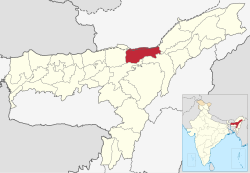Biswanath District | |
|---|---|
 Vasudeva Doul | |
 Location in Assam | |
| Country | |
| State | Assam |
| Division | North Assam |
| Incorporated (District) | 15 August 2015 |
| Headquarter | Biswanath Chariali |
| Government | |
| • Lok Sabha constituencies | Tezpur |
| • Vidhan Sabha constituencies | Biswanath, Behali, Gohpur |
| Area | |
• Total | 1,415 km2 (546 sq mi) |
| Elevation | 48−849 m (157−2,787 ft) |
| Population (2011) | |
• Total | 612,491 |
| • Density | 430/km2 (1,100/sq mi) |
| Languages | |
| • Official | Assamese |
| Time zone | UTC+5:30 (IST) |
| Vehicle registration | AS-32 |
| Website | biswanath.gov.in |
Biswanath (IPA: ˌbɪswəˈnɑːθ ˈtʃɑːrɪˌælɪ) is an administrative district in the state of Assam in India. It is one of newly created district in the year by 2015, declared by Assam Chief Minister Tarun Gogoi on 15 August 2015.[1][2]
The district is created amalgamating Gohpur and most part of Biswanath Sub division on earlier Sonitpur district. The district is bounded by Arunachal Pradesh on north, Golaghat, Brahmaputra River on the south, Lakhimpur district on the east and Sonitpur district on the west. The administrative headquarter is located at Biswanath Chariali.
On 31 December 2022, the district remerged with existing Sonitpur district ahead of delimitation process by ECI in the state.[3]
However, on August 25, 2023, the Assam cabinet announced the restoration of Biswanath's district status.[4]
History
[edit]The major part of Biswanath district formed a part of the Chutiya kingdom until it was annexed in the 16th century by the Ahoms. The western part of the district was under the rule of independent Bhuyan chieftains. The border between the Chutia kingdom and Bhuyan principalities were marked by the Dikarai [5] and the Ghiladhari rivers.[6] The Chutia kings built many forts in the region which included the Buroi fort (near Nyishi hills)[7] and the Pratapgarh fort built by king Pratap Narayan.[8][9] The Ita Fort lies to the north of Biswanath Chariali
Administration
[edit]- Headquarter
- Biswanath Chariali
- Name of Sub-Divisions
- Biswanath Chariali, Gohpur
- Name of Revenue Circles/ Tehsils
- Biswanath Chariali, Gohpur, Helem
- Name of Development(C.D.) Blocks
- Pub-Chaiduar Development Block
- Chaiduar Development Block
- Behali Development Block
- Baghmora Development Block
- Biswanath Development Block
- Sakomotha development Block
- Sotea Development Block
- Name of Police Stations
- Gohpur Police Station
- Helem Police Station
- Behali Police Station
- Ginjia Police Station
- Biswanath Chariali Police Station
- Sootea Police Station
- Hawajan Police Outpost
- Borgang Police Outpost
- Number of Villages
- 832
- Names of Towns
- Biswanath Chariali, Gohpur
- Name of Town Committees
- Biswanath Chariali, Gohpur
Demographics
[edit]According to the 2011 census, Biswanath district has a population of 612,491, of which 31,368 (5.12%) live in urban areas. Biswanath had a sex ratio of 968 females per 1000 males. Scheduled Castes and Scheduled Tribes make up 43,763 (7.15%) and 93,174 (15.21%) of the population respectively.[10]
As of the 2011 census, Hindus made up 514,259 (83.96%), while Muslims made up 52,155 (8.52%) and Christians (6.92%) of the population respectively.[11]
At the time of the 2011 census, 34.06% of the population speaks Assamese, 13.56% Sadri, 8.58% Bengali, 7.93% Nepali, 7.23% Boro, 7.09% Mising, 6.76% Odia, 3.41% Mundari, 2.56% Karbi and 1.84% Hindi as their first language.[12]
Railway Station
[edit]- Dubia
- Gohpur
- Brahmajan
- Helem
- Niz Borgang
- Monabari
- Viswanath Chariali
- Niz Sotea
See also
[edit]Notes
[edit]- ^ "CM Tarun Gogoi announces 5 new districts in Assam on Independence Day". Archived from the original on 2016-03-03. Retrieved 2016-01-27.
- ^ "Assam gets five more districts". 15 August 2015. Archived from the original on 25 April 2019. Retrieved 27 January 2016.
- ^ Tribune, The Assam (2022-12-31). "Assam: Four districts to re-merge with existing districts". assamtribune.com. Archived from the original on 2023-01-03. Retrieved 2023-01-03.
- ^ "Assam Cabinet decides to 'create' 4 districts". The Hindu. 25 August 2023. Archived from the original on 26 August 2023. Retrieved 26 August 2023.
- ^ (Baruah 1986:193)
- ^ (Neog 1980:66)
- ^ Basu, Nagendra Nath. Thee Social History of Kamrupa,1988, p. 271.
- ^ Bilgrami, Syaed Ali. Journal Of The Asiatic Society Of Bengal,1904, p. 258.
- ^ The stone inscription found in Umatamani, Biswanath states that a king named Lakshminah was crowned as the Lord of Pratapapura (Pratapapura-adhikari Dalapati Shri Lakshminah). This was none other than the Chutia king Lakshminarayan
- ^ "District Census Handbook: Sonitpur" (PDF). censusindia.gov.in. Registrar General and Census Commissioner of India. 2011. Archived (PDF) from the original on 2024-08-20. Retrieved 2023-03-27.
- ^ a b "Table C-01 Population By Religion: Assam". census.gov.in. Registrar General and Census Commissioner of India. 2011. Archived from the original on 2023-03-27. Retrieved 2023-03-27.
- ^ a b "Table C-16 Population By Mother Tongue: Assam". censusindia.gov.in. Registrar General and Census Commissioner of India. 2011. Archived from the original on 2022-08-09. Retrieved 2023-03-27.
References
[edit]- Baruah, S L (1986), A Comprehensive History of Assam, New Delhi: Munshiram Manoharlal Publishers Pvt. Ltd.
- Neog, Maheswar (1980). Early History of the Vaiṣṇava Faith and Movement in Assam: Śaṅkaradeva and His Times. Delhi: Motilal Banarsidass.
